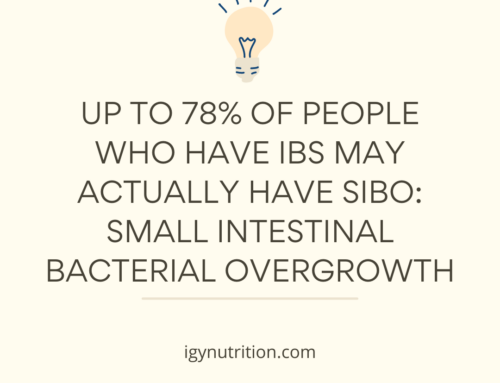Are you constantly bloated, no matter what you eat? Do you experience constipation, diarrhea, or a mix of both? If so, it might be a good idea to get checked for SIBO, small intestinal bacterial overgrowth.
What is SIBO?
SIBO occurs when too many bacteria (probiotic or harmful) inhabit the small intestine (1).
You might be thinking – hold on. I thought we had microbiomes in our intestines! Isn’t it a good thing to have gut bugs? Yes, but the microbiome is supposed to reside in the large intestine only (1).
The stomach and small intestine are intended to break down and absorb specific nutrients. If too many gut bugs migrate there, they can interfere with the unique processes that occur there and cause some nasty symptoms, including (1):
- Putrid gas
- Burping or reflux
- Bloating or extreme distention
- Constipation, diarrhea, or both
- Trouble focusing (“brain fog”)
- Poor memory
- Dysregulated or fluctuating weight
If you experience these symptoms, keep reading to learn more about small intestine bacterial overgrowth. If you don’t experience these symptoms, reading on will help you learn how to prevent developing SIBO.
Types of SIBO
The key to tackling SIBO is figuring out which type of it you have – treatment varies from type to type (although it is possible to have more than one type!) (1).
Each type of SIBO is classified by the strain of bacteria that invades the small intestine, the symptoms the patient experiences, and the type of gas the bacteria produces (yep, pretty gross).
There are three types: methane-dominant, hydrogen-dominant, and the less common hydrogen-sulfide-dominant. It’s possible to have more than one type at once (1).
The most notable difference between the three types of SIBO is the changes in motility that they cause. Methane-dominant SIBO usually causes constipation, hydrogen-dominant SIBO usually causes diarrhea, and hydrogen-sulfide-dominant SIBO usually causes a mix of both (1, 2, 3). All three cause foul gas.
Each type responds to different antibiotic treatments, so knowing which type you have is crucial to adequate treatment.
You might be thinking – okay, I have constipation, for example, so I guess I have methane-dominant SIBO. Not so fast – you could have more than one type of SIBO!
How can you tell which type you have? Testing!
Testing for SIBO
It’s vital to test for SIBO to ensure you have it in the first place and to see which type you have. That way, you can appropriately treat your symptoms.
The least invasive and cheapest way to test for SIBO is to order a dual breath test. Most gastroenterologists can prescribe one, and you can also order one online (which may be cheaper).
If you order a SIBO test from your doctor or elsewhere, ensure that it is a dual SIBO test, which tests for methane and hydrogen. There aren’t many great breath tests for hydrogen-sulfide small intestine bacterial overgrowth yet, though Gemelli Biotech carries one.
The breath test is pretty straightforward. You follow a plain diet for one day before the test. The following day, you drink a sweet, odd-tasting liquid. Next, you blow into a tube for a few seconds every 15 minutes over a few hours.
Based on the content of gas your body produces in response to drinking the liquid, scientists can tell whether you have a methane overgrowth, a hydrogen overgrowth, or neither.
The accuracy of breath tests for SIBO is controversial (4). The type of sugar used in the sweet liquid provided at the beginning of the test varies depending on the manufacturer. And each kind of sugar tends to produce different results.
It seems that tests that use lactulose (a type of sugar) are more likely to produce false positives, while tests that use glucose (another kind of sugar) are more accurate but may produce false negatives (4).
Since these tests’ results are debatable, some people treat SIBO based solely on symptoms. Working with a doctor or health professional, patients will experiment with treatments for small intestine bacterial overgrowth and see if it benefits them. This strategy can get expensive.
Regardless, getting tested is probably a good idea. Insurance typically covers the tests and buying one yourself usually runs you about $250. Working with a gastroenterologist or registered dietitian versed in treating SIBO is crucial to your recovery and accurately interpreting your results.
The Takeaway
SIBO is a nasty condition (literally). From dysregulated motility to smelly methane gas, it’s not something you want to deal with for long. The quicker you jump on handling your SIBO, the easier it will be to cure yourself.
References
- https://www.sciencedirect.com/topics/medicine-and-dentistry/small-intestinal-bacterial-overgrowth
- https://www.sciencedirect.com/science/article/abs/pii/S1542356521010491
- Guo HZ, Dong WX, Zhang X, Zhu SW, Liu ZJ, Duan LP. [The diagnostic value of hydrogen sulfide breath test for small intestinal bacterial overgrowth]. Zhonghua Nei Ke Za Zhi. 2021 Apr 1;60(4):356-361. Chinese. doi: 10.3760/cma.j.cn112138-20200731-00725. PMID: 33765706. https://pubmed.ncbi.nlm.nih.gov/33765706/
- Simrén, M, and P-O Stotzer. “Use and abuse of hydrogen breath tests.” Gut vol. 55,3 (2006): 297-303. doi:10.1136/gut.2005.075127 https://www.ncbi.nlm.nih.gov/pmc/articles/PMC1856094/#:~:text=Therefore%2C%20it%20is%20not%20surprising,test%2062%25%20and%2083%25.




